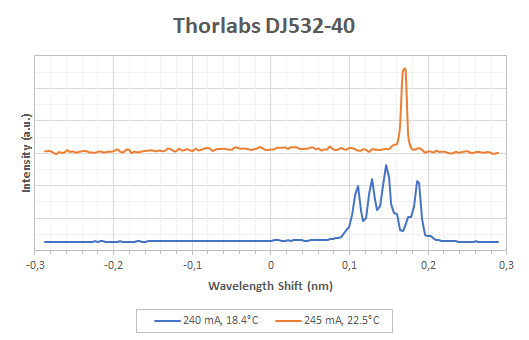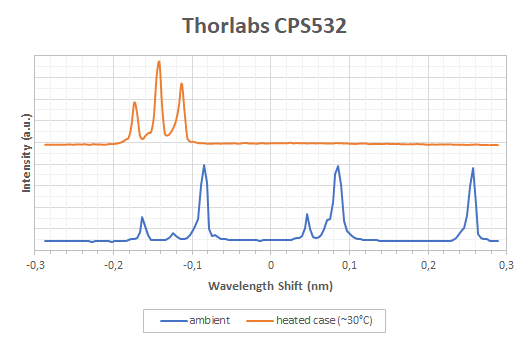Laser Longitudinal Modes Tuning
Operating a laser is far from being a trivial operation. Depending on the exact temperature and current you may experience completely different behaviors! This is illustrated in Figure 1 where you can see the high-resolution spectrum of the same laser diode, the Thorlabs DJ532-40 used in the OpenRAMAN Performance Edition, at two different set-points on the current and temperature controller.

In Figure 1, we can observe either a single sharp peak at 245 mA / 22.5°C or multiple peaks at 240 mA / 18.4°C. These peaks are called the longitudinal modes of the laser. When only one mode is present, we call the laser single (longitudinal) mode and when multiple modes are present we call the laser multimode. It is important to contextualize a bit when you talk about single mode laser because you could also be talking about spatial modes which are a different beast.
If you have followed the various posts on OpenRAMAN, you may recall that I often discuss about single and multimode lasers. This is because the spectral purity (i.e. number and position of the various longitudinal modes) is of primary importance in Raman spectroscopy.
Indeed, the Raman effect occurs at every excitation mode, and you will obtain the sum (a convolution) of each Raman emission which is here shifted copies of the spectrum since the lasing modes are close to each other. So, in summary, if you have two lasing modes separated by 0.1 nm you will get the sum of copies of your Raman spectra shifted by 0.1 nm (about 3 cm-1).
This is not so much important when the spectral width of the laser is relatively compact such as in Figure 1, but it becomes much more troublesome when you have widely separated modes such as in the low-cost Thorlabs CPS532 laser module.
Note that what was mentioned for the high-performance DJ532-40 laser is also applicable to the low-cost CPS532 as can be seen in Figure 2. By heating the case by a few degrees the longitudinal modes of the laser can be dramatically modified.

The effect of temperature and current on the lasing modes is however pretty tricky and experimentation is required to find a suitable (and stable) set-point. Also, not two lasers will behave the same, so it is important to calibrate your own laser for optimum operations.
In Figure 3, you can observe the effect of both current (at a fixed temperature) or the effect of temperature (at two fixed currents) on the DJ532-40 laser diode.

Changing the current within the operational range has the most drastic effect. You can see modes appearing and disappearing abruptly as you change the current. Sometimes the effect is progressive, as between 220 mA and 240 mA, or be very unstable, as when you go from 260 mA to 270 mA, or from 210 mA to 220 mA (still at 22.5°C).
Temperature change was found to be steadier here but still make a big difference since it can make your laser going from singlemode to multimode as can be seen by comparing 18°C and the range 21-25°C at 245 mA. Note that Figure 1 is basically obtained in these conditions.
Changing temperature does however not guarantee that you can alter the number of lasing modes as can be seen at 300 mA. At that current, which is near the nominal current to operate the laser at 40 mW, the spectral signature of the laser almost does not change on the 20-25°C temperature range.
Last but not least, it is also worth noting that set-point not only affect the spectral content of the laser but also the stability at high frequency as can be seen on the oscilloscope in Figure 4. These aspects are however less important as we are averaging the received light over a large timeframe in Raman spectroscopy. It is still a good thing to keep in mind because I’m pretty sure a laser showing a patent like on top of Figure 4 is trying to tell us it is not so happy!

All the spectra shown here have been taken using my high-resolution spectrometer. It was a convenient tool for the analysis of spectral modes but it is not mandatory per se to optimize your Raman spectrometer.
At the end, we are interested in the overall/convoluted spectra so a tuning technique could also be to use a sample with a very sharp peak, such as nitromethane, and to try out different current/temperature settings like I did in Figure 3 but this time looking at the FWHM of the Raman peak. At the proper setting, the peak width shall be minimal and have no shifted copies of itself.
In a future post, I will investigate further the performances of the cheap CPS532 to see if it can efficiently be tuned to increase the resolution of the OpenRAMAN Starter Edition to the one of the Performance Edition! I would like to give a big thanks to Young, Samuel, James, Lilith, Eric, Hitesh,Jesse, Sivaraman, Sebastian,Jon, Andrew, Themulticaster, Cory, Karel, Alex, Tayaab and Marcel who have supported this post through Patreon. I also take the occasion to invite you to donate through Patreon, even as little as $1. I cannot stress it more, you can really help me to post more content and make more experiments!
0 Comments